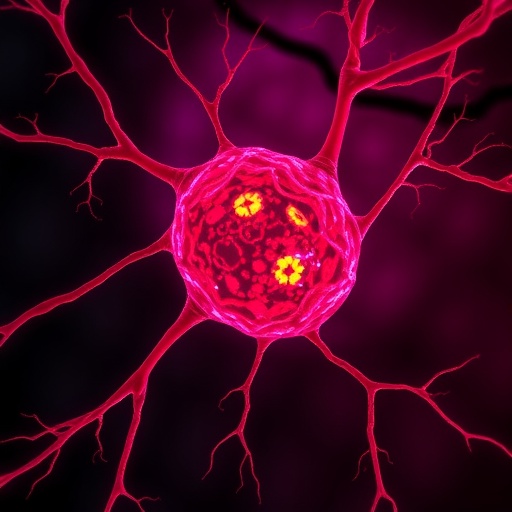In a groundbreaking study published in the journal Cell Death Discovery, researchers have unveiled a novel molecular pathway that exacerbates the progression of abdominal aortic aneurysm (AAA). This life-threatening vascular disease, characterized by the localized dilation of the abdominal aorta, poses significant challenges due to its asymptomatic nature and risk of sudden rupture. The study reveals how histone lactylation, a newly recognized post-translational modification, induces activation of the GLI3 transcription factor, which in turn promotes macrophage M1 polarization and triggers the secretion of exosomal SERPINE1, collectively accelerating aneurysm development.
The intricate interplay between epigenetic regulation and immune responses has become an intense area of investigation, especially within the context of chronic inflammatory conditions. Here, the researchers focused on histone lactylation, a modification discovered relatively recently that adds lactate groups to histones—a process linking cellular metabolism and gene expression. Their findings suggest that increased histone lactylation modulates macrophage phenotype shifts toward the pro-inflammatory M1 state by activating GLI3, a key transcription factor traditionally connected to developmental signaling pathways.
Macrophages are central players in AAA pathology, where the balance between M1 (pro-inflammatory) and M2 (anti-inflammatory) phenotypes critically influences disease trajectory. In AAA lesions, M1 macrophage dominance has been associated with exacerbated inflammation and tissue degradation. The elucidation of a histone lactylation-GLI3 axis as a driver of M1 polarization uncovers an epigenetic mechanism linking metabolic cues to inflammatory gene expression programs. This paradigm not only advances our understanding of aneurysm biology but also identifies new potential molecular targets for therapeutic intervention.
An intriguing aspect of this research is the role of exosomes—small extracellular vesicles implicated in cell-to-cell communication—in mediating pathological signaling. The study shows that M1 macrophages, upon GLI3 activation, enhance the release of exosomes enriched with SERPINE1, a serine protease inhibitor known to regulate extracellular matrix remodeling and inflammation. Elevated exosomal SERPINE1 appears to modulate the local vascular microenvironment, facilitating processes that weaken the aortic wall and promote aneurysm expansion.
The implications of identifying exosomal SERPINE1 as a critical effector molecule extend beyond mechanistic insights. Since exosomes can be isolated from bodily fluids, the detection of SERPINE1-enriched vesicles could serve as a minimally invasive biomarker for AAA progression. Moreover, therapeutic strategies aimed at modulating exosome content or inhibiting their release could represent innovative avenues to halt or slow aneurysm growth.
Methodologically, the study applied state-of-the-art epigenomic profiling techniques combined with single-cell RNA sequencing to dissect macrophage heterogeneity and track histone lactylation’s impact at a granular resolution. In vivo experiments using established murine AAA models corroborated the epigenetic findings, demonstrating that pharmacological blockade of lactylation or GLI3 signaling mitigated aneurysm formation and reduced levels of circulating exosomal SERPINE1.
Of critical interest was the metabolic reprogramming observed in aneurysmal macrophages, where elevated glycolysis increased intracellular lactate, fueling histone lactylation reactions. This metabolic-epigenetic axis positions cellular energy metabolism as a central regulator of inflammatory phenotype shifts and extracellular vesicle-mediated cross-talk in vascular disease. Such insights underscore the significance of systemic metabolic health in the etiology and progression of AAA.
The discovery of GLI3’s role outside its classical developmental context marks a notable advance. While GLI transcription factors have been historically studied in hedgehog signaling during embryogenesis, their function in adult inflammatory disorders is only beginning to surface. This study highlights GLI3’s versatility as a transcriptional regulator responsive to epigenetic cues shaped by metabolic state—and its pathogenic contribution when aberrantly activated.
From a clinical perspective, these findings pave the way for developing targeted therapies that disrupt the histone lactylation-GLI3-SERPINE1 axis. Given the absence of FDA-approved pharmacologic treatments specifically for AAA, interventions that modulate macrophage polarization or inhibit exosomal pathways could transform patient management. Such therapeutic innovations might reduce surgical interventions and improve outcomes for individuals with aneurysms detected at an earlier stage.
Furthermore, the identification of histone lactylation as a modifiable post-translational modification opens the door to a broader understanding of how metabolic dysregulation influences chronic inflammatory diseases outside AAA. This epigenetic mechanism may be relevant to atherosclerosis, fibrosis, and other cardiovascular pathologies where macrophage activation status is a determining factor.
The study’s multidisciplinary approach—intersecting vascular biology, immunology, metabolism, and epigenetics—exemplifies the future of biomedical research aimed at unraveling complex disease mechanisms. By integrating molecular biology with systems-level analysis, the investigators provide a comprehensive framework for understanding how cellular and microenvironmental factors converge to accelerate AAA progression.
Looking ahead, further research is warranted to explore the translational potential of these findings in human patients. Extensive validation of SERPINE1-containing exosomes as circulating biomarkers could facilitate earlier diagnosis and risk stratification. Moreover, designing small molecule inhibitors or RNA-based therapies targeting key nodes within this pathway may offer promising clinical utility.
In conclusion, this study represents a seminal contribution to the field of vascular disease research, illuminating a novel epigenetic-metabolic axis that governs macrophage behavior and intercellular communication through exosomes in abdominal aortic aneurysm pathology. By deciphering the molecular underpinnings of aneurysm progression, the work not only enriches our fundamental biological knowledge but also charts a course toward innovative diagnostics and therapeutic strategies aimed at curbing this silent but deadly disease.
Subject of Research:
Article Title:
Article References:
Yuan, K., Liu, J., Chen, G. et al. Histone lactylation-induced GLI3 activation drives macrophage M1 polarization and exosomal SERPINE1 release in abdominal aortic aneurysm progression. Cell Death Discov. 11, 523 (2025). https://doi.org/10.1038/s41420-025-02748-7
Image Credits: AI Generated
DOI: 10 November 2025
Tags: abdominal aortic aneurysm progressionaneurysm pathology and inflammationchronic inflammatory conditions and aneurysmsepigenetic regulation of inflammationexosomal SERPINE1 secretionGLI3 transcription factor rolehistone lactylation and macrophage activationM1 versus M2 macrophage phenotypesmacrophage polarization in vascular diseasesmetabolic influence on gene expressionpost-translational modifications in diseasevascular disease immune response





